Impact of Technology on Cybersecurity: Analyzing Cybercrime Trends
VerifiedAdded on 2024/04/29
|10
|2516
|434
Report
AI Summary
This assignment comprises a report analyzing the negative impacts of technology on cybersecurity, particularly focusing on cybercrime, its prevalence, and impact on individuals, businesses, and society, along with strategies to overcome these challenges. It includes an overview of cybercrime trends, vulnerabilities in technological structures, regulatory challenges, business impacts, and societal issues. Furthermore, the assignment addresses the impact of climate change on agricultural practices, exploring challenges like rising temperatures, changing weather patterns, soil health issues, water scarcity, and pest outbreaks. It suggests adaptation and mitigation strategies to improve agricultural resilience. The assignment concludes with a reflection on improvements made from the initial draft, emphasizing enhanced structure, clarity, and in-depth analysis. Desklib provides this assignment as a study resource, offering access to past papers and solved assignments for students.

Paraphrase This Document
Need a fresh take? Get an instant paraphrase of this document with our AI Paraphraser
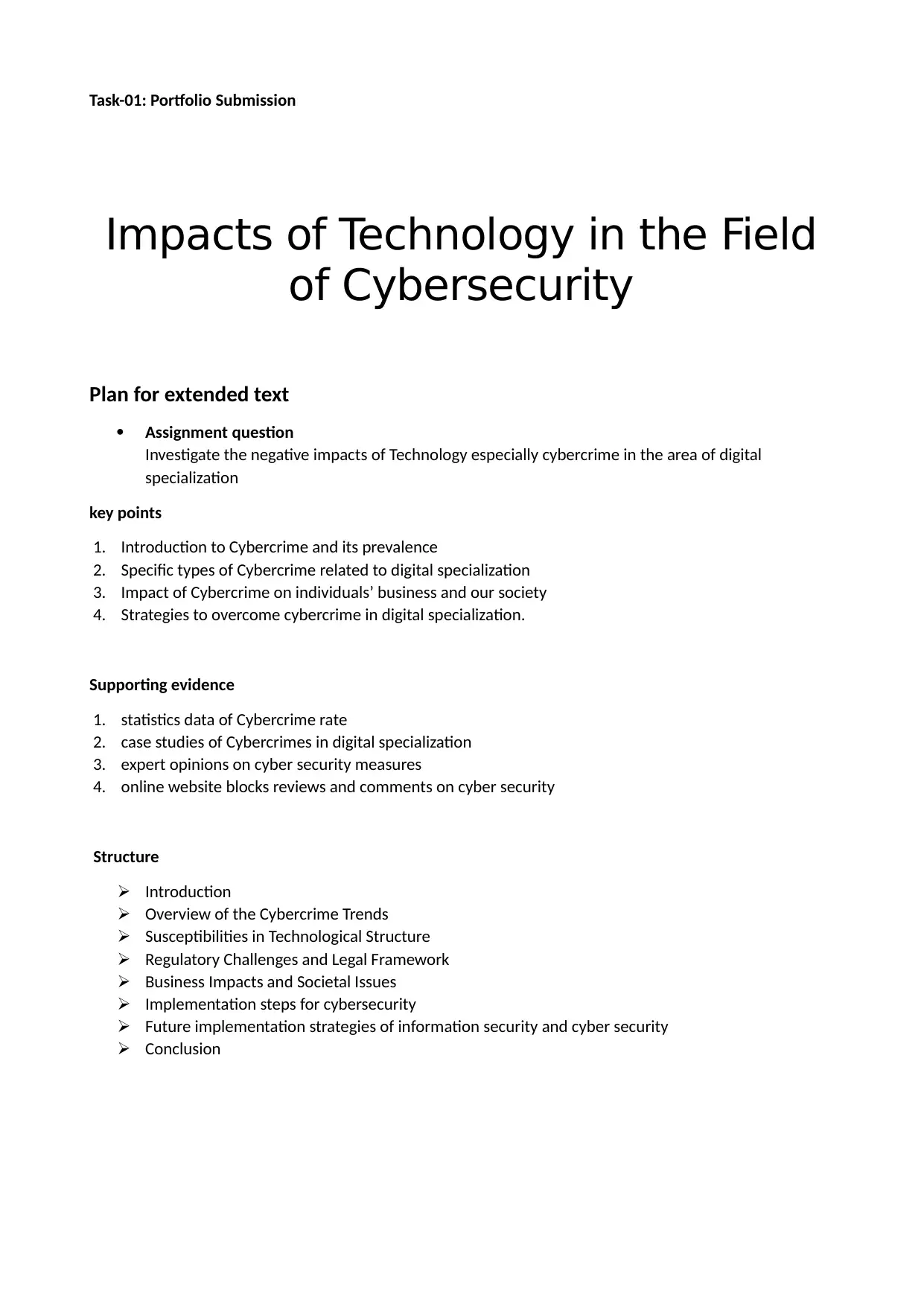
Task-01: Portfolio Submission
Impacts of Technology in the Field
of Cybersecurity
Plan for extended text
Assignment question
Investigate the negative impacts of Technology especially cybercrime in the area of digital
specialization
key points
1. Introduction to Cybercrime and its prevalence
2. Specific types of Cybercrime related to digital specialization
3. Impact of Cybercrime on individuals’ business and our society
4. Strategies to overcome cybercrime in digital specialization.
Supporting evidence
1. statistics data of Cybercrime rate
2. case studies of Cybercrimes in digital specialization
3. expert opinions on cyber security measures
4. online website blocks reviews and comments on cyber security
Structure
Introduction
Overview of the Cybercrime Trends
Susceptibilities in Technological Structure
Regulatory Challenges and Legal Framework
Business Impacts and Societal Issues
Implementation steps for cybersecurity
Future implementation strategies of information security and cyber security
Conclusion
Impacts of Technology in the Field
of Cybersecurity
Plan for extended text
Assignment question
Investigate the negative impacts of Technology especially cybercrime in the area of digital
specialization
key points
1. Introduction to Cybercrime and its prevalence
2. Specific types of Cybercrime related to digital specialization
3. Impact of Cybercrime on individuals’ business and our society
4. Strategies to overcome cybercrime in digital specialization.
Supporting evidence
1. statistics data of Cybercrime rate
2. case studies of Cybercrimes in digital specialization
3. expert opinions on cyber security measures
4. online website blocks reviews and comments on cyber security
Structure
Introduction
Overview of the Cybercrime Trends
Susceptibilities in Technological Structure
Regulatory Challenges and Legal Framework
Business Impacts and Societal Issues
Implementation steps for cybersecurity
Future implementation strategies of information security and cyber security
Conclusion
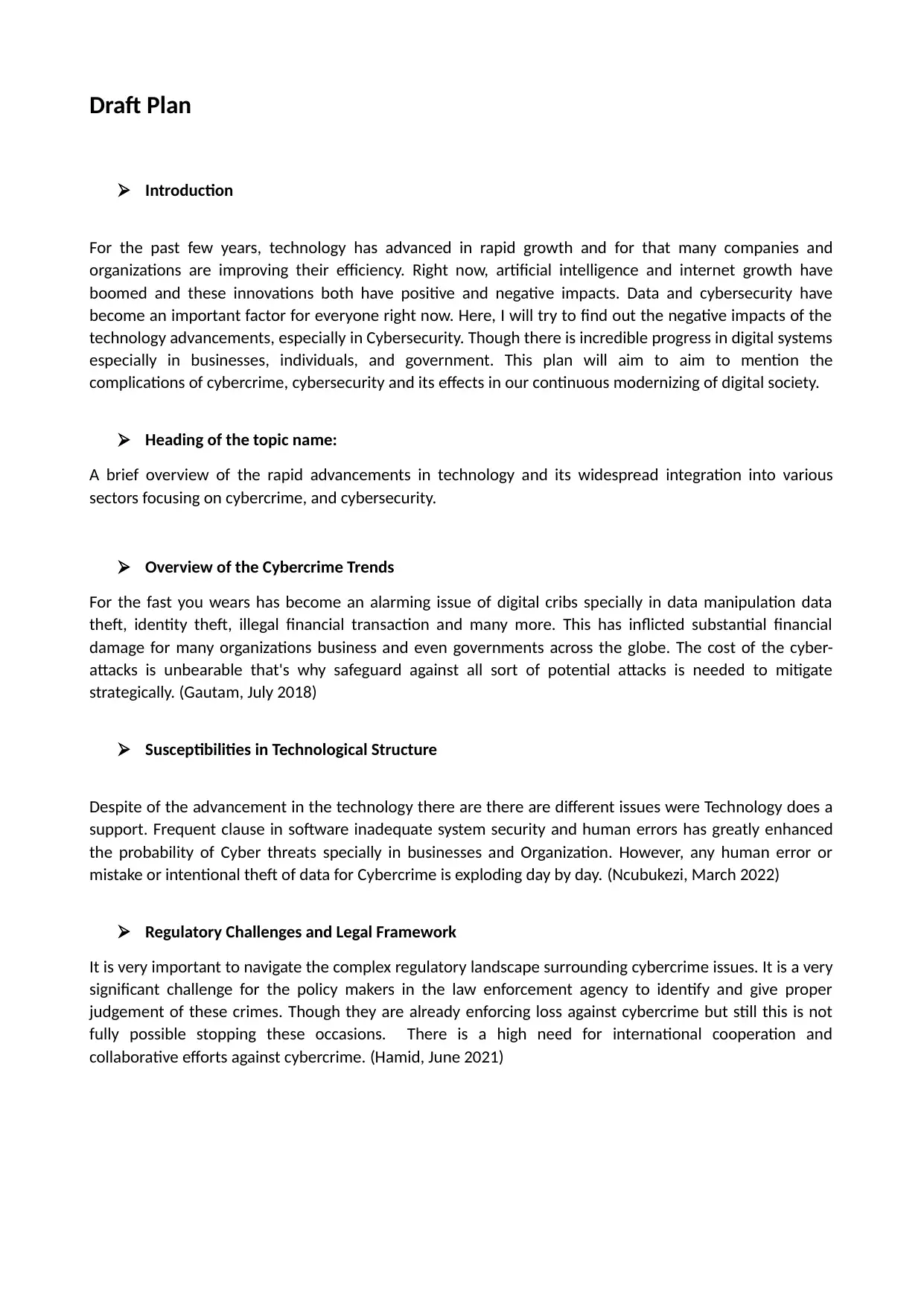
Draft Plan
Introduction
For the past few years, technology has advanced in rapid growth and for that many companies and
organizations are improving their efficiency. Right now, artificial intelligence and internet growth have
boomed and these innovations both have positive and negative impacts. Data and cybersecurity have
become an important factor for everyone right now. Here, I will try to find out the negative impacts of the
technology advancements, especially in Cybersecurity. Though there is incredible progress in digital systems
especially in businesses, individuals, and government. This plan will aim to aim to mention the
complications of cybercrime, cybersecurity and its effects in our continuous modernizing of digital society.
Heading of the topic name:
A brief overview of the rapid advancements in technology and its widespread integration into various
sectors focusing on cybercrime, and cybersecurity.
Overview of the Cybercrime Trends
For the fast you wears has become an alarming issue of digital cribs specially in data manipulation data
theft, identity theft, illegal financial transaction and many more. This has inflicted substantial financial
damage for many organizations business and even governments across the globe. The cost of the cyber-
attacks is unbearable that's why safeguard against all sort of potential attacks is needed to mitigate
strategically. (Gautam, July 2018)
Susceptibilities in Technological Structure
Despite of the advancement in the technology there are there are different issues were Technology does a
support. Frequent clause in software inadequate system security and human errors has greatly enhanced
the probability of Cyber threats specially in businesses and Organization. However, any human error or
mistake or intentional theft of data for Cybercrime is exploding day by day. (Ncubukezi, March 2022)
Regulatory Challenges and Legal Framework
It is very important to navigate the complex regulatory landscape surrounding cybercrime issues. It is a very
significant challenge for the policy makers in the law enforcement agency to identify and give proper
judgement of these crimes. Though they are already enforcing loss against cybercrime but still this is not
fully possible stopping these occasions. There is a high need for international cooperation and
collaborative efforts against cybercrime. (Hamid, June 2021)
Introduction
For the past few years, technology has advanced in rapid growth and for that many companies and
organizations are improving their efficiency. Right now, artificial intelligence and internet growth have
boomed and these innovations both have positive and negative impacts. Data and cybersecurity have
become an important factor for everyone right now. Here, I will try to find out the negative impacts of the
technology advancements, especially in Cybersecurity. Though there is incredible progress in digital systems
especially in businesses, individuals, and government. This plan will aim to aim to mention the
complications of cybercrime, cybersecurity and its effects in our continuous modernizing of digital society.
Heading of the topic name:
A brief overview of the rapid advancements in technology and its widespread integration into various
sectors focusing on cybercrime, and cybersecurity.
Overview of the Cybercrime Trends
For the fast you wears has become an alarming issue of digital cribs specially in data manipulation data
theft, identity theft, illegal financial transaction and many more. This has inflicted substantial financial
damage for many organizations business and even governments across the globe. The cost of the cyber-
attacks is unbearable that's why safeguard against all sort of potential attacks is needed to mitigate
strategically. (Gautam, July 2018)
Susceptibilities in Technological Structure
Despite of the advancement in the technology there are there are different issues were Technology does a
support. Frequent clause in software inadequate system security and human errors has greatly enhanced
the probability of Cyber threats specially in businesses and Organization. However, any human error or
mistake or intentional theft of data for Cybercrime is exploding day by day. (Ncubukezi, March 2022)
Regulatory Challenges and Legal Framework
It is very important to navigate the complex regulatory landscape surrounding cybercrime issues. It is a very
significant challenge for the policy makers in the law enforcement agency to identify and give proper
judgement of these crimes. Though they are already enforcing loss against cybercrime but still this is not
fully possible stopping these occasions. There is a high need for international cooperation and
collaborative efforts against cybercrime. (Hamid, June 2021)
⊘ This is a preview!⊘
Do you want full access?
Subscribe today to unlock all pages.

Trusted by 1+ million students worldwide
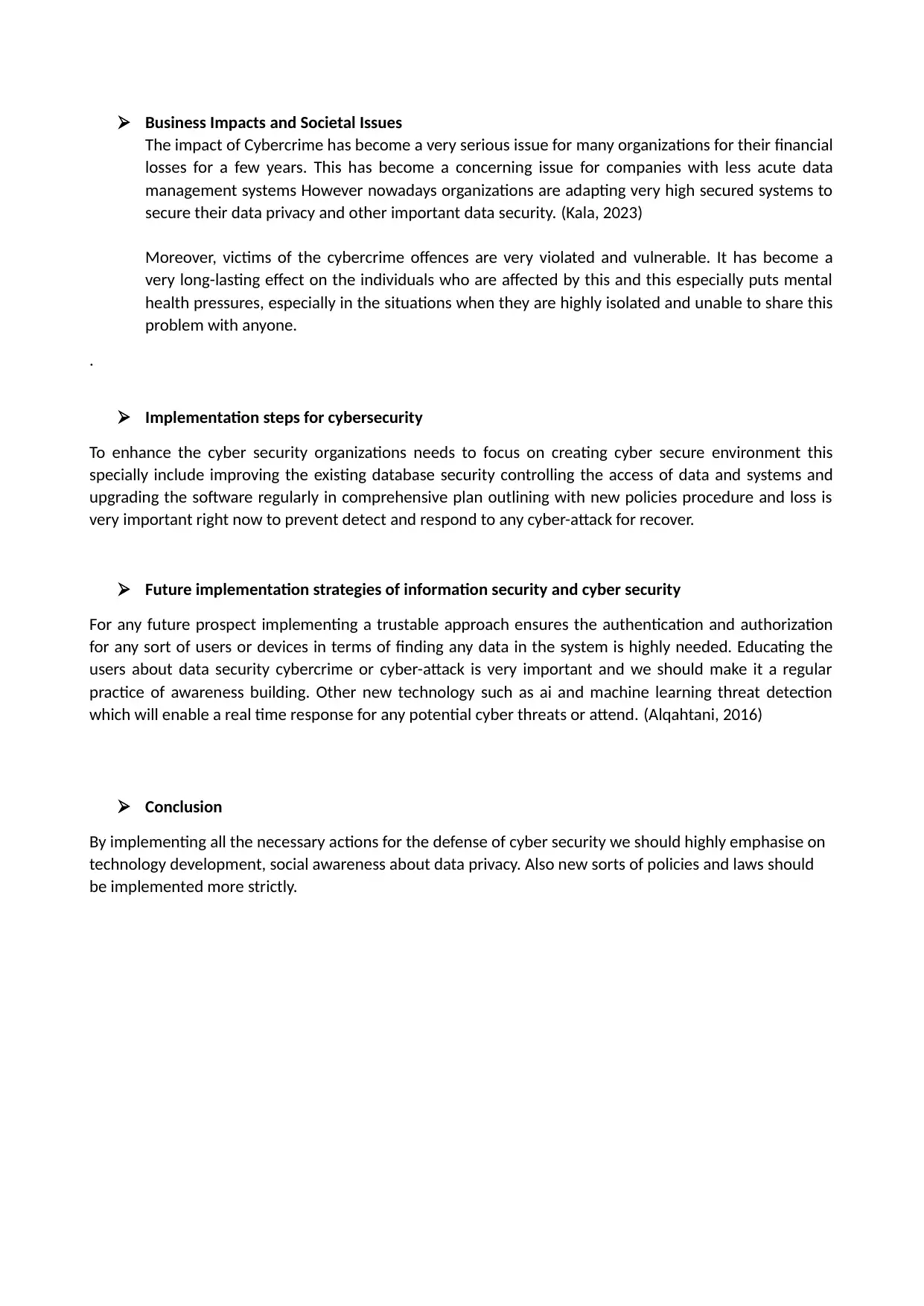
Business Impacts and Societal Issues
The impact of Cybercrime has become a very serious issue for many organizations for their financial
losses for a few years. This has become a concerning issue for companies with less acute data
management systems However nowadays organizations are adapting very high secured systems to
secure their data privacy and other important data security. (Kala, 2023)
Moreover, victims of the cybercrime offences are very violated and vulnerable. It has become a
very long-lasting effect on the individuals who are affected by this and this especially puts mental
health pressures, especially in the situations when they are highly isolated and unable to share this
problem with anyone.
.
Implementation steps for cybersecurity
To enhance the cyber security organizations needs to focus on creating cyber secure environment this
specially include improving the existing database security controlling the access of data and systems and
upgrading the software regularly in comprehensive plan outlining with new policies procedure and loss is
very important right now to prevent detect and respond to any cyber-attack for recover.
Future implementation strategies of information security and cyber security
For any future prospect implementing a trustable approach ensures the authentication and authorization
for any sort of users or devices in terms of finding any data in the system is highly needed. Educating the
users about data security cybercrime or cyber-attack is very important and we should make it a regular
practice of awareness building. Other new technology such as ai and machine learning threat detection
which will enable a real time response for any potential cyber threats or attend. (Alqahtani, 2016)
Conclusion
By implementing all the necessary actions for the defense of cyber security we should highly emphasise on
technology development, social awareness about data privacy. Also new sorts of policies and laws should
be implemented more strictly.
The impact of Cybercrime has become a very serious issue for many organizations for their financial
losses for a few years. This has become a concerning issue for companies with less acute data
management systems However nowadays organizations are adapting very high secured systems to
secure their data privacy and other important data security. (Kala, 2023)
Moreover, victims of the cybercrime offences are very violated and vulnerable. It has become a
very long-lasting effect on the individuals who are affected by this and this especially puts mental
health pressures, especially in the situations when they are highly isolated and unable to share this
problem with anyone.
.
Implementation steps for cybersecurity
To enhance the cyber security organizations needs to focus on creating cyber secure environment this
specially include improving the existing database security controlling the access of data and systems and
upgrading the software regularly in comprehensive plan outlining with new policies procedure and loss is
very important right now to prevent detect and respond to any cyber-attack for recover.
Future implementation strategies of information security and cyber security
For any future prospect implementing a trustable approach ensures the authentication and authorization
for any sort of users or devices in terms of finding any data in the system is highly needed. Educating the
users about data security cybercrime or cyber-attack is very important and we should make it a regular
practice of awareness building. Other new technology such as ai and machine learning threat detection
which will enable a real time response for any potential cyber threats or attend. (Alqahtani, 2016)
Conclusion
By implementing all the necessary actions for the defense of cyber security we should highly emphasise on
technology development, social awareness about data privacy. Also new sorts of policies and laws should
be implemented more strictly.
Paraphrase This Document
Need a fresh take? Get an instant paraphrase of this document with our AI Paraphraser
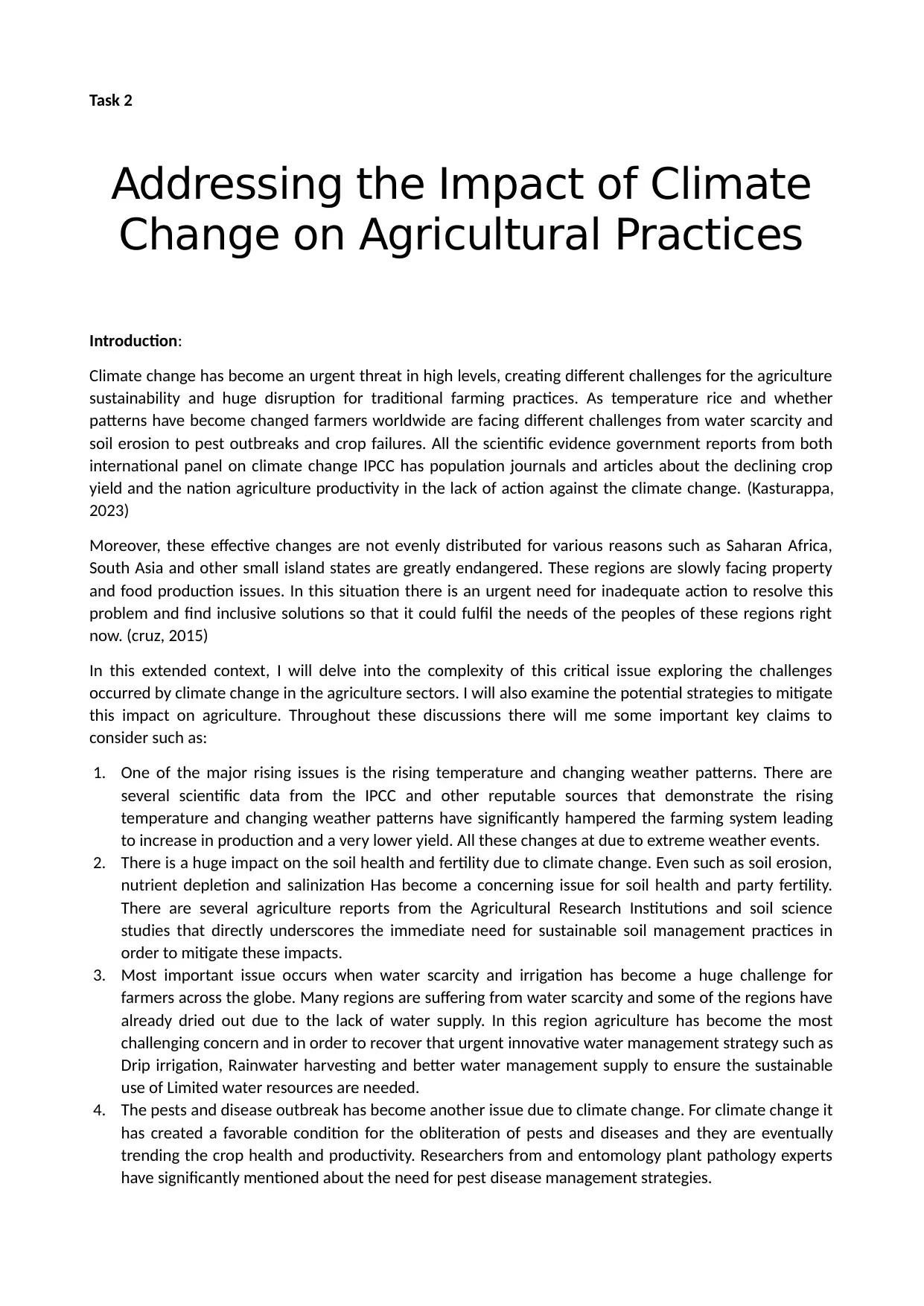
Task 2
Addressing the Impact of Climate
Change on Agricultural Practices
Introduction:
Climate change has become an urgent threat in high levels, creating different challenges for the agriculture
sustainability and huge disruption for traditional farming practices. As temperature rice and whether
patterns have become changed farmers worldwide are facing different challenges from water scarcity and
soil erosion to pest outbreaks and crop failures. All the scientific evidence government reports from both
international panel on climate change IPCC has population journals and articles about the declining crop
yield and the nation agriculture productivity in the lack of action against the climate change. (Kasturappa,
2023)
Moreover, these effective changes are not evenly distributed for various reasons such as Saharan Africa,
South Asia and other small island states are greatly endangered. These regions are slowly facing property
and food production issues. In this situation there is an urgent need for inadequate action to resolve this
problem and find inclusive solutions so that it could fulfil the needs of the peoples of these regions right
now. (cruz, 2015)
In this extended context, I will delve into the complexity of this critical issue exploring the challenges
occurred by climate change in the agriculture sectors. I will also examine the potential strategies to mitigate
this impact on agriculture. Throughout these discussions there will me some important key claims to
consider such as:
1. One of the major rising issues is the rising temperature and changing weather patterns. There are
several scientific data from the IPCC and other reputable sources that demonstrate the rising
temperature and changing weather patterns have significantly hampered the farming system leading
to increase in production and a very lower yield. All these changes at due to extreme weather events.
2. There is a huge impact on the soil health and fertility due to climate change. Even such as soil erosion,
nutrient depletion and salinization Has become a concerning issue for soil health and party fertility.
There are several agriculture reports from the Agricultural Research Institutions and soil science
studies that directly underscores the immediate need for sustainable soil management practices in
order to mitigate these impacts.
3. Most important issue occurs when water scarcity and irrigation has become a huge challenge for
farmers across the globe. Many regions are suffering from water scarcity and some of the regions have
already dried out due to the lack of water supply. In this region agriculture has become the most
challenging concern and in order to recover that urgent innovative water management strategy such as
Drip irrigation, Rainwater harvesting and better water management supply to ensure the sustainable
use of Limited water resources are needed.
4. The pests and disease outbreak has become another issue due to climate change. For climate change it
has created a favorable condition for the obliteration of pests and diseases and they are eventually
trending the crop health and productivity. Researchers from and entomology plant pathology experts
have significantly mentioned about the need for pest disease management strategies.
Addressing the Impact of Climate
Change on Agricultural Practices
Introduction:
Climate change has become an urgent threat in high levels, creating different challenges for the agriculture
sustainability and huge disruption for traditional farming practices. As temperature rice and whether
patterns have become changed farmers worldwide are facing different challenges from water scarcity and
soil erosion to pest outbreaks and crop failures. All the scientific evidence government reports from both
international panel on climate change IPCC has population journals and articles about the declining crop
yield and the nation agriculture productivity in the lack of action against the climate change. (Kasturappa,
2023)
Moreover, these effective changes are not evenly distributed for various reasons such as Saharan Africa,
South Asia and other small island states are greatly endangered. These regions are slowly facing property
and food production issues. In this situation there is an urgent need for inadequate action to resolve this
problem and find inclusive solutions so that it could fulfil the needs of the peoples of these regions right
now. (cruz, 2015)
In this extended context, I will delve into the complexity of this critical issue exploring the challenges
occurred by climate change in the agriculture sectors. I will also examine the potential strategies to mitigate
this impact on agriculture. Throughout these discussions there will me some important key claims to
consider such as:
1. One of the major rising issues is the rising temperature and changing weather patterns. There are
several scientific data from the IPCC and other reputable sources that demonstrate the rising
temperature and changing weather patterns have significantly hampered the farming system leading
to increase in production and a very lower yield. All these changes at due to extreme weather events.
2. There is a huge impact on the soil health and fertility due to climate change. Even such as soil erosion,
nutrient depletion and salinization Has become a concerning issue for soil health and party fertility.
There are several agriculture reports from the Agricultural Research Institutions and soil science
studies that directly underscores the immediate need for sustainable soil management practices in
order to mitigate these impacts.
3. Most important issue occurs when water scarcity and irrigation has become a huge challenge for
farmers across the globe. Many regions are suffering from water scarcity and some of the regions have
already dried out due to the lack of water supply. In this region agriculture has become the most
challenging concern and in order to recover that urgent innovative water management strategy such as
Drip irrigation, Rainwater harvesting and better water management supply to ensure the sustainable
use of Limited water resources are needed.
4. The pests and disease outbreak has become another issue due to climate change. For climate change it
has created a favorable condition for the obliteration of pests and diseases and they are eventually
trending the crop health and productivity. Researchers from and entomology plant pathology experts
have significantly mentioned about the need for pest disease management strategies.
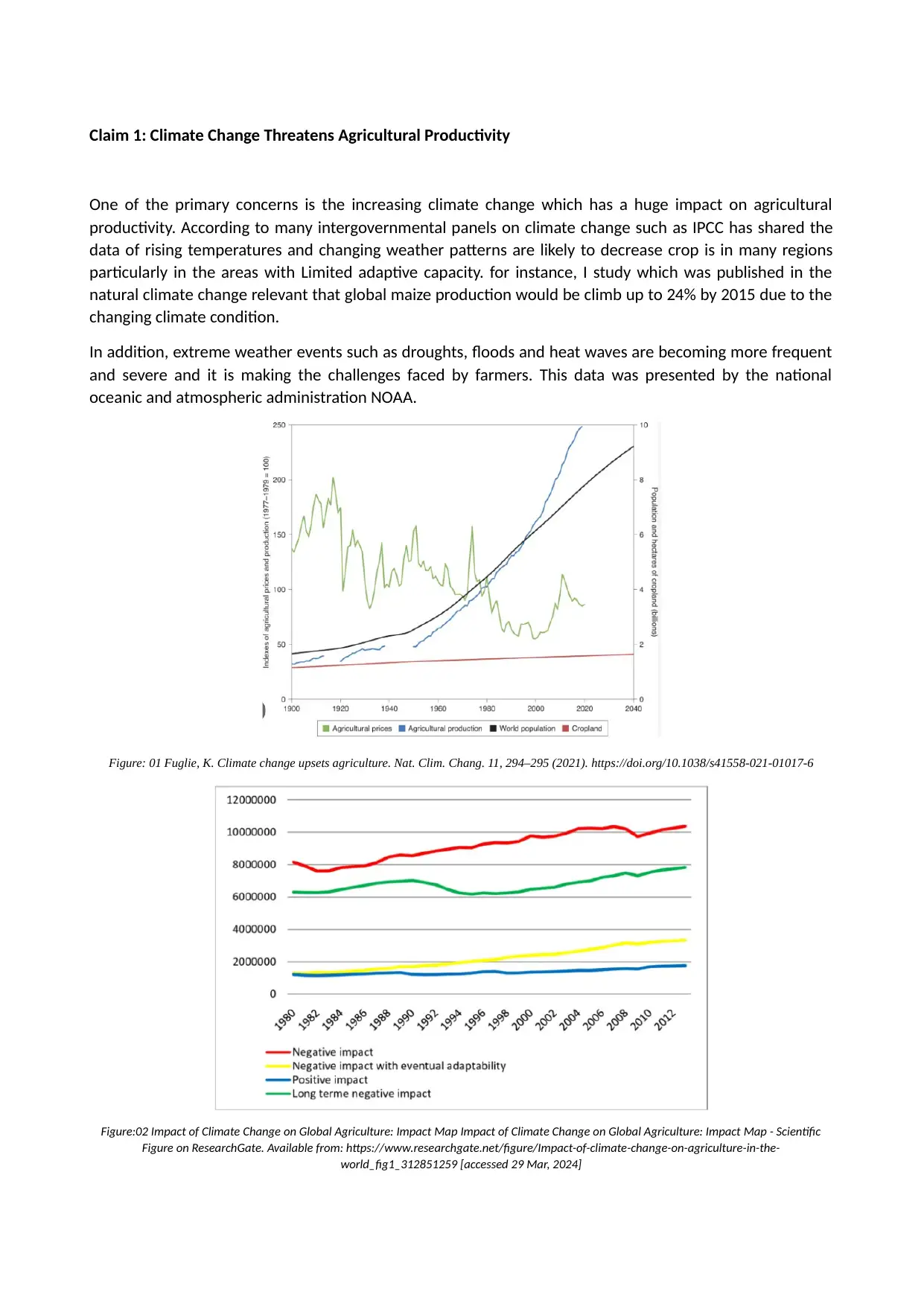
Claim 1: Climate Change Threatens Agricultural Productivity
One of the primary concerns is the increasing climate change which has a huge impact on agricultural
productivity. According to many intergovernmental panels on climate change such as IPCC has shared the
data of rising temperatures and changing weather patterns are likely to decrease crop is in many regions
particularly in the areas with Limited adaptive capacity. for instance, I study which was published in the
natural climate change relevant that global maize production would be climb up to 24% by 2015 due to the
changing climate condition.
In addition, extreme weather events such as droughts, floods and heat waves are becoming more frequent
and severe and it is making the challenges faced by farmers. This data was presented by the national
oceanic and atmospheric administration NOAA.
Figure: 01 Fuglie, K. Climate change upsets agriculture. Nat. Clim. Chang. 11, 294–295 (2021). https://doi.org/10.1038/s41558-021-01017-6
Figure:02 Impact of Climate Change on Global Agriculture: Impact Map Impact of Climate Change on Global Agriculture: Impact Map - Scientific
Figure on ResearchGate. Available from: https://www.researchgate.net/figure/Impact-of-climate-change-on-agriculture-in-the-
world_fig1_312851259 [accessed 29 Mar, 2024]
One of the primary concerns is the increasing climate change which has a huge impact on agricultural
productivity. According to many intergovernmental panels on climate change such as IPCC has shared the
data of rising temperatures and changing weather patterns are likely to decrease crop is in many regions
particularly in the areas with Limited adaptive capacity. for instance, I study which was published in the
natural climate change relevant that global maize production would be climb up to 24% by 2015 due to the
changing climate condition.
In addition, extreme weather events such as droughts, floods and heat waves are becoming more frequent
and severe and it is making the challenges faced by farmers. This data was presented by the national
oceanic and atmospheric administration NOAA.
Figure: 01 Fuglie, K. Climate change upsets agriculture. Nat. Clim. Chang. 11, 294–295 (2021). https://doi.org/10.1038/s41558-021-01017-6
Figure:02 Impact of Climate Change on Global Agriculture: Impact Map Impact of Climate Change on Global Agriculture: Impact Map - Scientific
Figure on ResearchGate. Available from: https://www.researchgate.net/figure/Impact-of-climate-change-on-agriculture-in-the-
world_fig1_312851259 [accessed 29 Mar, 2024]
⊘ This is a preview!⊘
Do you want full access?
Subscribe today to unlock all pages.

Trusted by 1+ million students worldwide
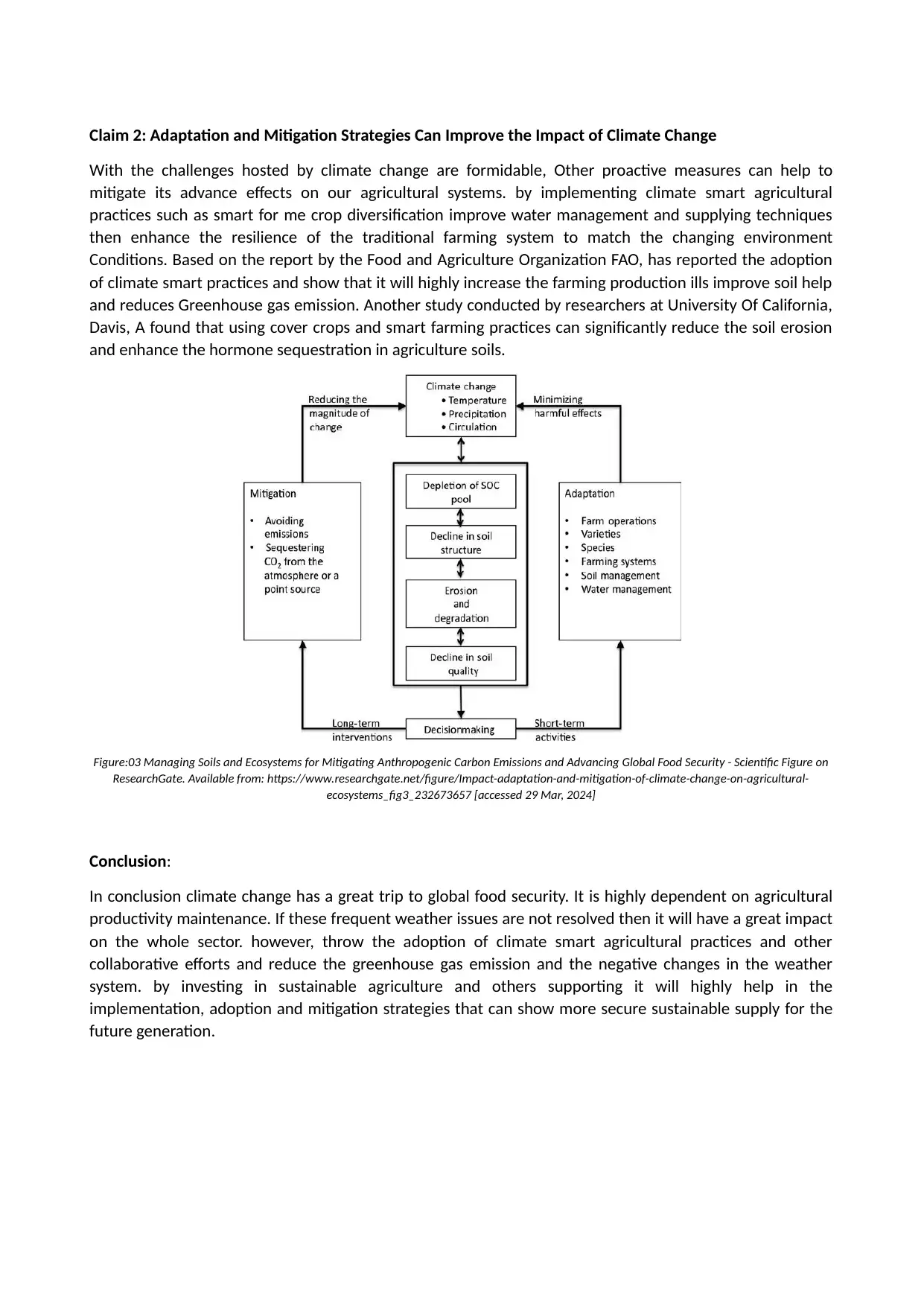
Claim 2: Adaptation and Mitigation Strategies Can Improve the Impact of Climate Change
With the challenges hosted by climate change are formidable, Other proactive measures can help to
mitigate its advance effects on our agricultural systems. by implementing climate smart agricultural
practices such as smart for me crop diversification improve water management and supplying techniques
then enhance the resilience of the traditional farming system to match the changing environment
Conditions. Based on the report by the Food and Agriculture Organization FAO, has reported the adoption
of climate smart practices and show that it will highly increase the farming production ills improve soil help
and reduces Greenhouse gas emission. Another study conducted by researchers at University Of California,
Davis, A found that using cover crops and smart farming practices can significantly reduce the soil erosion
and enhance the hormone sequestration in agriculture soils.
Figure:03 Managing Soils and Ecosystems for Mitigating Anthropogenic Carbon Emissions and Advancing Global Food Security - Scientific Figure on
ResearchGate. Available from: https://www.researchgate.net/figure/Impact-adaptation-and-mitigation-of-climate-change-on-agricultural-
ecosystems_fig3_232673657 [accessed 29 Mar, 2024]
Conclusion:
In conclusion climate change has a great trip to global food security. It is highly dependent on agricultural
productivity maintenance. If these frequent weather issues are not resolved then it will have a great impact
on the whole sector. however, throw the adoption of climate smart agricultural practices and other
collaborative efforts and reduce the greenhouse gas emission and the negative changes in the weather
system. by investing in sustainable agriculture and others supporting it will highly help in the
implementation, adoption and mitigation strategies that can show more secure sustainable supply for the
future generation.
With the challenges hosted by climate change are formidable, Other proactive measures can help to
mitigate its advance effects on our agricultural systems. by implementing climate smart agricultural
practices such as smart for me crop diversification improve water management and supplying techniques
then enhance the resilience of the traditional farming system to match the changing environment
Conditions. Based on the report by the Food and Agriculture Organization FAO, has reported the adoption
of climate smart practices and show that it will highly increase the farming production ills improve soil help
and reduces Greenhouse gas emission. Another study conducted by researchers at University Of California,
Davis, A found that using cover crops and smart farming practices can significantly reduce the soil erosion
and enhance the hormone sequestration in agriculture soils.
Figure:03 Managing Soils and Ecosystems for Mitigating Anthropogenic Carbon Emissions and Advancing Global Food Security - Scientific Figure on
ResearchGate. Available from: https://www.researchgate.net/figure/Impact-adaptation-and-mitigation-of-climate-change-on-agricultural-
ecosystems_fig3_232673657 [accessed 29 Mar, 2024]
Conclusion:
In conclusion climate change has a great trip to global food security. It is highly dependent on agricultural
productivity maintenance. If these frequent weather issues are not resolved then it will have a great impact
on the whole sector. however, throw the adoption of climate smart agricultural practices and other
collaborative efforts and reduce the greenhouse gas emission and the negative changes in the weather
system. by investing in sustainable agriculture and others supporting it will highly help in the
implementation, adoption and mitigation strategies that can show more secure sustainable supply for the
future generation.
Paraphrase This Document
Need a fresh take? Get an instant paraphrase of this document with our AI Paraphraser
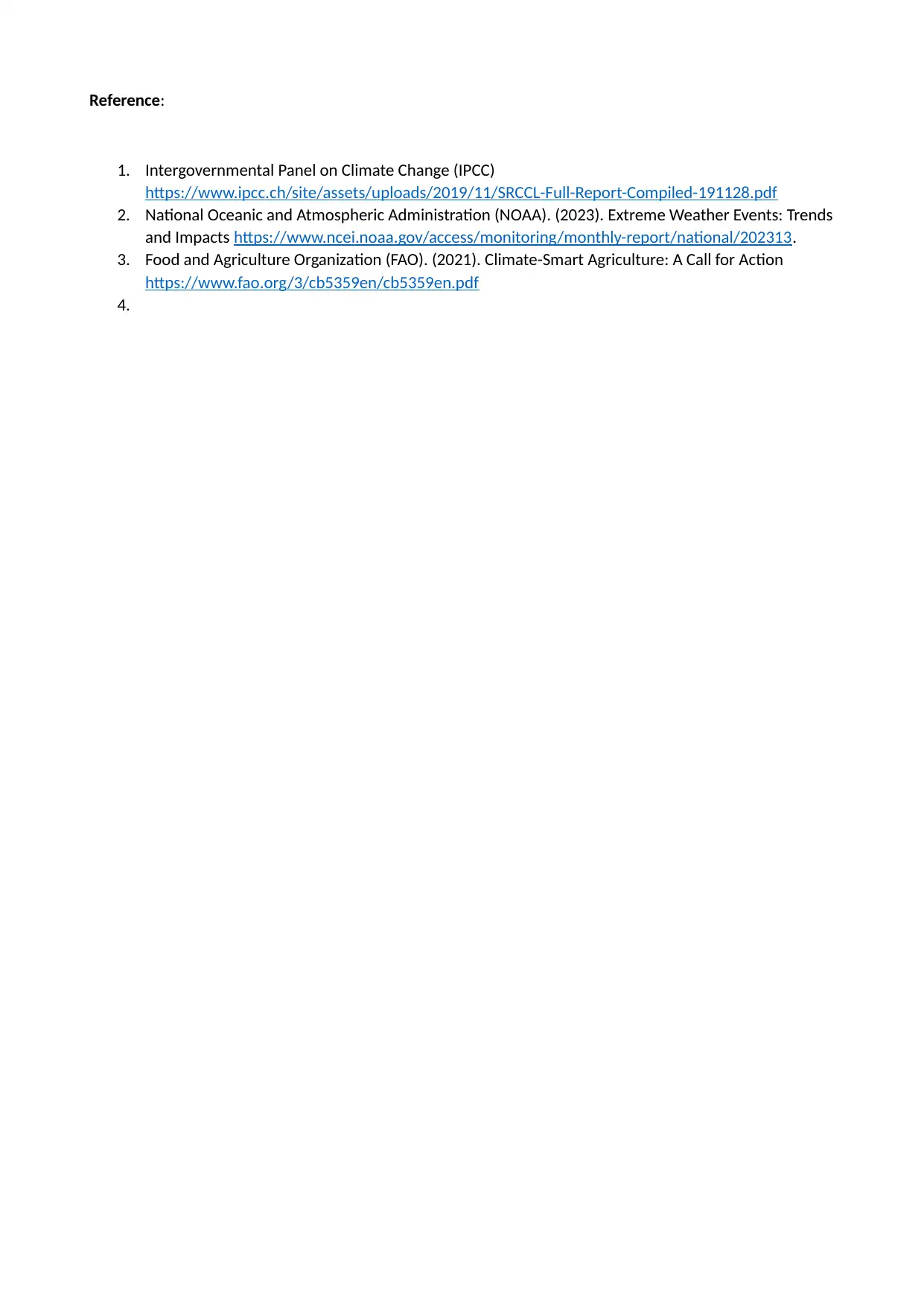
Reference:
1. Intergovernmental Panel on Climate Change (IPCC)
https://www.ipcc.ch/site/assets/uploads/2019/11/SRCCL-Full-Report-Compiled-191128.pdf
2. National Oceanic and Atmospheric Administration (NOAA). (2023). Extreme Weather Events: Trends
and Impacts https://www.ncei.noaa.gov/access/monitoring/monthly-report/national/202313.
3. Food and Agriculture Organization (FAO). (2021). Climate-Smart Agriculture: A Call for Action
https://www.fao.org/3/cb5359en/cb5359en.pdf
4.
1. Intergovernmental Panel on Climate Change (IPCC)
https://www.ipcc.ch/site/assets/uploads/2019/11/SRCCL-Full-Report-Compiled-191128.pdf
2. National Oceanic and Atmospheric Administration (NOAA). (2023). Extreme Weather Events: Trends
and Impacts https://www.ncei.noaa.gov/access/monitoring/monthly-report/national/202313.
3. Food and Agriculture Organization (FAO). (2021). Climate-Smart Agriculture: A Call for Action
https://www.fao.org/3/cb5359en/cb5359en.pdf
4.

Task:03
Reflection on Changes from Draft
In the process of revising my return text from the draft in task 1 I have greatly experienced significant
growth in different areas of my academic writing. One important and noticeable improvement is in the
crafting and structure making of my paper.
In this draft my ideas have been showcased and viewed in a cohesive flow. However, I was able to recognize
my thoughts more logically and create a more structured argument. This has improved my introduction to a
clear outline of the purpose and the scope of the writing. Also, each paragraph is written smoothly next by
next reinforcing the main argument.
In addition, I have strength in my ability to clearly precise my writing in English language. They are instances
of ambiguity and unnecessary verbosity was cleared for my arguments. I have learnt how to eliminate
unnecessary words and phrases and clarify my statements and ensured my writing was to the point.
Furthermore, I have learnt how to make my analysis more in- depth and specific. In the drafting of my
analysis, I was somewhat superficial. I was lacking in the death and critical engagement with the topic.
However, my further content searching and finding and reviving different academy to tell me go deep into
the main subject matter.
Now moving for what are still areas of my academic writing that I would highly like to develop. One of the
areas is my ability to effectively and synthesize the content sources. I also have to improve the quality of my
writing and enhance my academic credibility.
Lastly, to continue developing my academic writing skills I plan to see and study more and take necessary
feedback. I will engage in writing and exercises to enhance my writing skills. Additionally, I will continue to
read widely, especially the academic lectures.
Reflection on Changes from Draft
In the process of revising my return text from the draft in task 1 I have greatly experienced significant
growth in different areas of my academic writing. One important and noticeable improvement is in the
crafting and structure making of my paper.
In this draft my ideas have been showcased and viewed in a cohesive flow. However, I was able to recognize
my thoughts more logically and create a more structured argument. This has improved my introduction to a
clear outline of the purpose and the scope of the writing. Also, each paragraph is written smoothly next by
next reinforcing the main argument.
In addition, I have strength in my ability to clearly precise my writing in English language. They are instances
of ambiguity and unnecessary verbosity was cleared for my arguments. I have learnt how to eliminate
unnecessary words and phrases and clarify my statements and ensured my writing was to the point.
Furthermore, I have learnt how to make my analysis more in- depth and specific. In the drafting of my
analysis, I was somewhat superficial. I was lacking in the death and critical engagement with the topic.
However, my further content searching and finding and reviving different academy to tell me go deep into
the main subject matter.
Now moving for what are still areas of my academic writing that I would highly like to develop. One of the
areas is my ability to effectively and synthesize the content sources. I also have to improve the quality of my
writing and enhance my academic credibility.
Lastly, to continue developing my academic writing skills I plan to see and study more and take necessary
feedback. I will engage in writing and exercises to enhance my writing skills. Additionally, I will continue to
read widely, especially the academic lectures.
⊘ This is a preview!⊘
Do you want full access?
Subscribe today to unlock all pages.

Trusted by 1+ million students worldwide
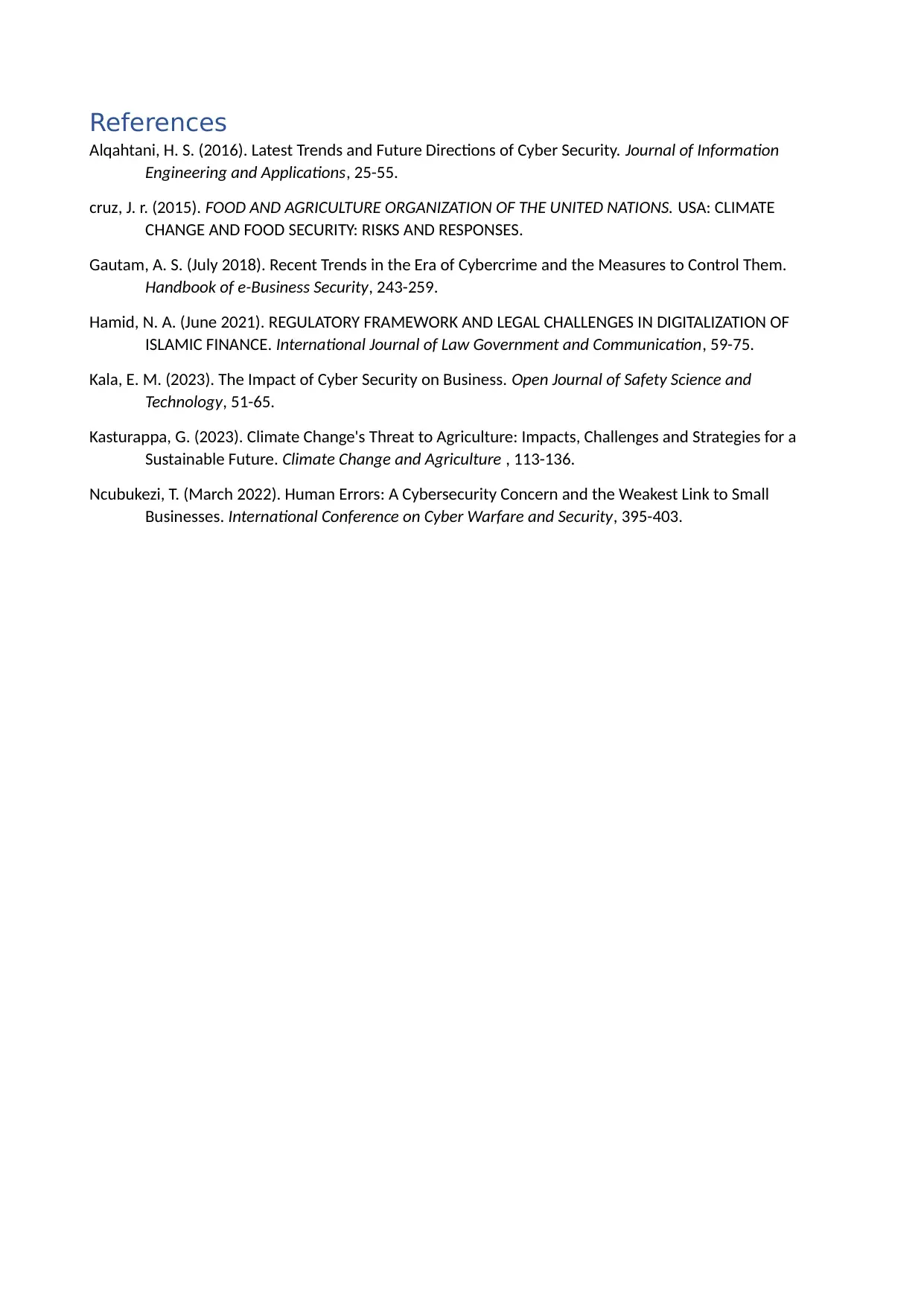
References
Alqahtani, H. S. (2016). Latest Trends and Future Directions of Cyber Security. Journal of Information
Engineering and Applications, 25-55.
cruz, J. r. (2015). FOOD AND AGRICULTURE ORGANIZATION OF THE UNITED NATIONS. USA: CLIMATE
CHANGE AND FOOD SECURITY: RISKS AND RESPONSES.
Gautam, A. S. (July 2018). Recent Trends in the Era of Cybercrime and the Measures to Control Them.
Handbook of e-Business Security, 243-259.
Hamid, N. A. (June 2021). REGULATORY FRAMEWORK AND LEGAL CHALLENGES IN DIGITALIZATION OF
ISLAMIC FINANCE. International Journal of Law Government and Communication, 59-75.
Kala, E. M. (2023). The Impact of Cyber Security on Business. Open Journal of Safety Science and
Technology, 51-65.
Kasturappa, G. (2023). Climate Change's Threat to Agriculture: Impacts, Challenges and Strategies for a
Sustainable Future. Climate Change and Agriculture , 113-136.
Ncubukezi, T. (March 2022). Human Errors: A Cybersecurity Concern and the Weakest Link to Small
Businesses. International Conference on Cyber Warfare and Security, 395-403.
Alqahtani, H. S. (2016). Latest Trends and Future Directions of Cyber Security. Journal of Information
Engineering and Applications, 25-55.
cruz, J. r. (2015). FOOD AND AGRICULTURE ORGANIZATION OF THE UNITED NATIONS. USA: CLIMATE
CHANGE AND FOOD SECURITY: RISKS AND RESPONSES.
Gautam, A. S. (July 2018). Recent Trends in the Era of Cybercrime and the Measures to Control Them.
Handbook of e-Business Security, 243-259.
Hamid, N. A. (June 2021). REGULATORY FRAMEWORK AND LEGAL CHALLENGES IN DIGITALIZATION OF
ISLAMIC FINANCE. International Journal of Law Government and Communication, 59-75.
Kala, E. M. (2023). The Impact of Cyber Security on Business. Open Journal of Safety Science and
Technology, 51-65.
Kasturappa, G. (2023). Climate Change's Threat to Agriculture: Impacts, Challenges and Strategies for a
Sustainable Future. Climate Change and Agriculture , 113-136.
Ncubukezi, T. (March 2022). Human Errors: A Cybersecurity Concern and the Weakest Link to Small
Businesses. International Conference on Cyber Warfare and Security, 395-403.
1 out of 10
Related Documents
Your All-in-One AI-Powered Toolkit for Academic Success.
+13062052269
info@desklib.com
Available 24*7 on WhatsApp / Email
![[object Object]](/_next/static/media/star-bottom.7253800d.svg)
Unlock your academic potential
Copyright © 2020–2025 A2Z Services. All Rights Reserved. Developed and managed by ZUCOL.





![Cyber Security Research Paper Abstract - [University] - [Course Name]](/_next/image/?url=https%3A%2F%2Fdesklib.com%2Fmedia%2Fimages%2Fbd%2F04151bc652ee49f480e5594ea23a69c7.jpg&w=256&q=75)